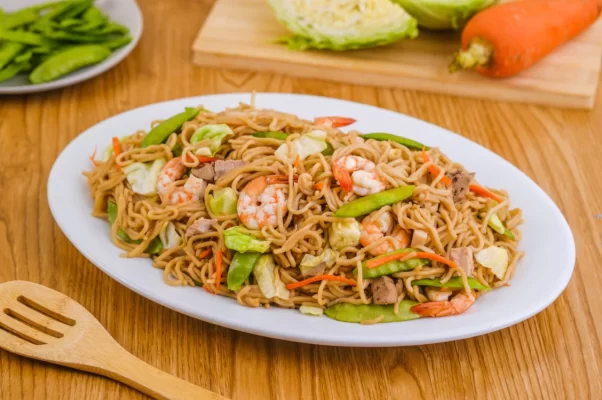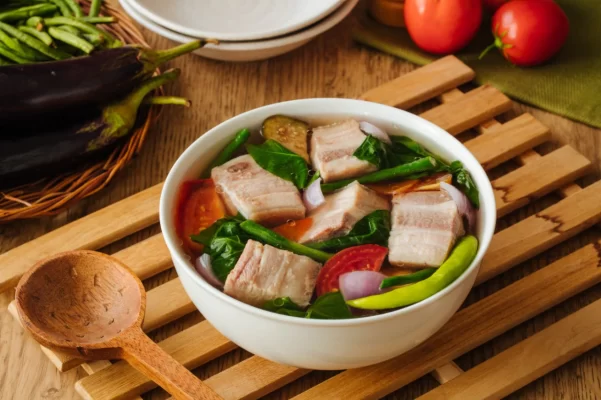Craving Filipino food and want to try your skills in the kitchen? We got you covered! We’ve handpicked some mouthwatering recipes to give you that masarap na pagkain (delicious food) right in the comfort of your home.
Filipino cuisine has become incredibly popular worldwide, and it’s no wonder why. It’s known for its bold flavors, unique ingredient combinations, and the perfect balance of sweet, salty, and sour tastes. From savory meals to delightful desserts, Filipino food offers diverse flavors that satisfy your cravings.
We’ve gathered a collection of Filipino recipes easy to cook that anyone can prepare, whether you’re an experienced cook or just starting. These recipes will help you recreate authentic tastes without fuss.
So, let’s dive into Filipino cooking and discover the joy of preparing these easy and delicious dishes. You’ll impress your loved ones with the flavors as you enjoy the best of this fantastic cuisine in the comfort of your own home. Put on your apron, and let’s get started!
Adobo
First on our list is the adobo, a beloved and iconic Filipino dish that captures the essence of Filipino cuisine and is sometimes referred to as the Philippines’ national dish. It is a flavorful and comforting dish that showcases the perfect blend of sweet, savory, and tangy flavors. The beauty of adobo lies in its simplicity, making it a fantastic choice for anyone looking to try their hand at Filipino cooking.

Here’s a simple recipe for adobo chicken that you can easily whip up in your kitchen. The best part? It requires just a handful of ingredients and minimal effort, making it a perfect choice for busy individuals or those new to Filipino cooking.
Ingredients:
- 1.5 lbs (680g) chicken pieces (legs, thighs, or a combination) or pork belly
- 1/2 cup soy sauce
- 1/2 cup vinegar (white vinegar or apple cider vinegar works well)
- 4 cloves garlic, minced
- 1 bay leaf
- 1 teaspoon whole black peppercorns
- 1 tablespoon cooking oil
Instructions:
- Combine the soy sauce, vinegar, minced garlic, bay leaf, and black peppercorns in a large bowl. Give it a good stir to mix everything.
- Add the meat to the marinade and toss them gently to ensure they are well coated. Let it marinate for at least 30 minutes, but for even more flavor, you can marinate it for a few hours or overnight in the refrigerator.
- Heat the cooking oil in a large skillet or pot over medium-high heat. Remove the meat from the marinade (reserve the marinade for later) and place the chicken pieces in the hot pan. Cook the chicken until it is browned on all sides, which should take about 5 minutes.
- Pour the reserved marinade into the pot with the chicken or pork. Bring it to a boil, then reduce the heat to low and cover the pot. Let it simmer gently for 30 to 40 minutes or until the chicken is tender and cooked.
- Once it is cooked, you can thicken the sauce by removing the lid and letting it simmer for a few more minutes. This step is optional but adds a richer consistency to the dish.
- Serve the adobo hot over steamed rice, and remember to spoon some of that delicious sauce over the top.
Adobo is a delightfully simple dish that showcases the harmonious flavors of soy sauce, vinegar, and garlic. The long, slow cooking process allows the chicken to absorb all the wonderful flavors, resulting in tender, juicy meat infused with adobo’s essence.
You can create an authentic Filipino dish that will impress your taste buds with basic ingredients and straightforward cooking techniques. Try this adobo chicken recipe and experience the essence of Filipino cooking in your kitchen.

Pancit Canton
Pancit Canton is a beloved Filipino noodle dish that has become a staple in Filipino cuisine. It is a flavorful and satisfying dish that combines the goodness of noodles, vegetables, and proteins in one delicious plate. Pancit canton has gained popularity in the Philippines and among food enthusiasts worldwide with its simplicity and versatility.
Here’s a straightforward recipe for pancit canton that you can easily prepare in your kitchen. The best part? You can customize it by adding your favorite vegetables and proteins, making it a versatile and adaptable dish.
Ingredients:
- 8 ounces (225g) pancit canton noodles (or any egg noodles)
- 2 tablespoons cooking oil
- 4 cloves garlic, minced
- 1 small onion, sliced
- 1 cup sliced chicken, pork, or shrimp (or a combination)
- 1 cup assorted vegetables (carrots, cabbage, bell peppers, snow peas, etc.), thinly sliced
- 2 tablespoons soy sauce
- 2 tablespoons oyster sauce
- 1 cup chicken or vegetable broth
- Salt and pepper to taste
- Calamansi or lemon wedges (optional), for serving
Instructions:
- Cook the pancit canton noodles according to the package instructions. Drain and set aside.
- Heat the cooking oil in a large skillet or wok over medium heat. Add the minced garlic, sliced onion, and sauté until fragrant and the onion becomes translucent.
- Add the sliced chicken, pork, or shrimp to the skillet until cooked and slightly browned.
- Toss in the assorted vegetables and stir-fry for a few minutes until they are crisp-tender.
- Mix the soy sauce, oyster sauce, and chicken or vegetable broth in a small bowl. Pour the sauce mixture into the skillet with the cooked meat and vegetables.
- Add the cooked pancit canton noodles to the skillet and toss everything together until the noodles are well coated with the sauce. Continue to stir-fry for a few more minutes until the noodles have absorbed the flavors and are heated through.
- Season with salt and pepper to taste, adjusting the seasoning as desired.
- Remove from heat and serve the pancit canton hot, garnished with calamansi or lemon wedges if desired.
Pancit canton traditionally uses pancit canton noodles, but if you can’t find them, you can substitute them with any egg noodles available. These noodles provide a satisfying chewiness to the dish, absorbing the flavors of the sauce and ingredients.
The beauty of pancit canton lies in its versatility. You can add vegetables like carrots, cabbage, bell peppers, snow peas, and more. Feel free to experiment and use your favorite combination of vegetables. Additionally, you can include sliced chicken, pork, shrimp, or various proteins to enhance the dish’s flavor and texture.
Sinigang
Sinigang is a beloved Filipino soup known for its comforting and tangy flavors – a perfect dish during rainy days. It is a dish that warms the body and the soul, making it a popular choice for family gatherings and rainy days. Sinigang showcases the perfect balance of sourness and savory goodness, making it a delightful culinary experience.

Here’s an uncomplicated recipe for sinigang soup that you can prepare in a jiffy. The beauty of sinigang lies in its quick preparation, allowing you to enjoy a flavorful bowl of soup without spending hours in the kitchen.
Ingredients:
- 8 cups water
- 1 pound (450g) protein of your choice (pork, beef, chicken, shrimp, or fish)
- 1 medium onion, quartered
- 2 medium tomatoes, quartered
- 2-3 pieces tamarind soup base (sinigang mix)
- 2 cups assorted vegetables (radish, eggplant, okra, spinach, kangkong, etc.)
- Salt or fish sauce to taste
- Fresh cilantro or scallions for garnish (optional)
Instructions:
- Bring the water to a boil over medium heat in a large pot.
- Add the protein of your choice (pork, beef, chicken, shrimp, or fish) to the boiling water. If using meat, let it simmer until tender and cooked through. If using shrimp or fish, cook for a shorter time to avoid overcooking.
- Add the quartered onions and tomatoes to the pot and continue to simmer for a few more minutes until they soften.
- Stir in the tamarind soup base (sinigang mix) and let it dissolve in the soup. Adjust the amount based on your desired level of sourness.
- Add the assorted vegetables to the pot and cook until tender but still slightly crisp.
- Season the soup with salt or fish sauce to taste, adjusting the seasoning according to your preference.
- Remove the pot from the heat and serve the sinigang soup hot. Optionally, garnish with fresh cilantro or scallions for added freshness and aroma.
Sinigang offers a beautiful variety of protein and vegetable options, allowing you to customize the dish to your liking. You can choose from pork, beef, chicken, shrimp, or fish as your protein base. Each option lends its unique flavor profile to the soup.
As for the vegetables, you can add a combination of radish, eggplant, okra, spinach, kangkong (water spinach), or any other vegetables that you prefer. The vegetables contribute to the soup’s texture and freshness, enhancing the overall taste.

Lumpia
Lumpia is the Filipino version of spring rolls and is a popular and beloved dish in Filipino cuisine. These delectable rolls are filled with a savory mixture and wrapped in a thin pastry wrapper. Whether enjoyed as an appetizer, snack, or even a main course, lumpia is a crowd-pleaser that is loved by many.
Here’s an easy-to-follow lumpia recipe highlighting the simplicity of the filling and wrapping process. With just a few ingredients and straightforward steps, you can create these crispy and flavorful rolls in no time.
Ingredients:
- 1 pack of lumpia wrappers (spring roll wrappers)
- 1 pound (450g) ground pork or chicken
- 1 cup shredded cabbage
- 1 cup grated carrots
- 1 medium onion, finely chopped
- 2 cloves garlic, minced
- 2 tablespoons soy sauce
- Salt and pepper to taste
- Cooking oil for frying
Instructions:
- Combine the ground pork or chicken, shredded cabbage, grated carrots, chopped onion, minced garlic, soy sauce, salt, and pepper in a large bowl. Mix well until all the ingredients are evenly incorporated.
- Take a lumpia wrapper and place it on a clean surface—spoon about 2 tablespoons of the filling mixture onto the center of the wrapper.
- Start rolling the wrapper tightly, folding the sides inward as you go. Moisten the edges of the wrapper with water to seal it securely.
- Repeat the process with the remaining wrappers and filling until all the lumpia are assembled.
- Heat cooking oil in a deep pan or skillet over medium heat. Fry the lumpia in batches until they turn golden brown and crispy. Drain them on a paper towel-lined plate to remove any excess oil.
- Serve the lumpia hot with dipping sauces, such as sweet chili sauce, vinegar with garlic and soy sauce, or spicy banana ketchup.
Lumpia is incredibly versatile and can be enjoyed in various ways. Try making it into a breakfast idea Filipino style, “lumpiasilog.” Serve the lumpia with garlic fried rice (sinangag) and a sunny-side-up egg (itlog) for a delicious and satisfying morning treat.
Remember to dip your lumpia in your favorite sauce for extra flavor. Whether you prefer a sweet and tangy sauce or a savory and spicy one, the dipping sauce adds a layer of deliciousness to the delightful lumpia.

Halo-Halo
Now let’s have something sweet! Halo-halo is a well-loved and iconic Filipino dessert that has captured dessert lovers’ hearts and taste buds. The name “halo-halo” translates to “mix-mix” in English, perfectly describing this delightful treat’s essence. It is a refreshing and colorful dessert with a medley of ingredients layered together, resulting in a delightful symphony of flavors and textures.
Here’s a recipe for halo-halo that showcases the versatility of ingredients and the ease of assembly. You’ll be able to create this delightful dessert in no time, customizing it to your liking and enjoying a fantastic and satisfying treat.
Ingredients:
- Crushed ice
- Sweetened fruits (such as sweetened bananas, sweetened beans, and sweetened jackfruit)
- Cooked sweet beans (such as kidney beans, garbanzo beans, and red beans)
- Jellies (such as coconut jelly, nata de coco)
- Sweetened macapuno (shredded young coconut)
- Leche flan (caramel custard)
- Ube (purple yam) or other flavored ice cream
- Evaporated milk
- Sugar or condensed milk (optional)
- Toppings of your choice (such as toasted rice crispies, cornflakes, or crushed peanuts)
Instructions:
- Fill a tall glass or bowl halfway with crushed ice.
- Start layering the sweetened fruits, cooked sweet beans, and jellies over the ice. You can add as much or as little of each ingredient as possible.
- Spoon some sweetened macapuno over the layered ingredients.
- Add a slice or two of leche flan on top.
- Place a scoop of ube or other flavored ice cream on the leche flan.
- Pour a generous amount of evaporated milk over the layers.
- Optionally, you can add some sugar or condensed milk for added sweetness.
- Finish off your halo-halo by sprinkling your choice of toppings over the top.
Halo-halo is a dessert that allows for creativity and personalization. You can mix and match the ingredients based on your preferences or what you have available. Feel free to add your favorite fruits, jellies, or unique elements like boba pearls or cereal.
When assembling halo-halo, it’s important to note that the layers and textures contribute to the overall experience. Each spoonful brings a delightful combination of sweet, creamy, and icy flavors. As you enjoy halo-halo, mix everything, savoring the harmonious blend of ingredients.
Halo-halo is not just a dessert; it’s an experience. It offers a refreshing respite from the heat and a delightful indulgence for your taste buds.
Conclusion
Filipino cuisine offers a wide array of dishes that are not only mouthwatering but also accessible to cooks of all levels. With simple ingredients and straightforward techniques, you can recreate the flavors and aromas of the Philippines right in your kitchen.
So, don’t hesitate to embark on a culinary adventure and explore the world of Filipino recipes. Let the easy-to-follow instructions and the availability of ingredients guide you as you whip up these delightful dishes. Whether you’re seeking comfort, a taste of something new, or a connection to Filipino culture, these recipes offer a satisfying journey for your taste buds.
Remember, the beauty of Filipino cuisine lies in its ability to bring people together, create memorable meals, and celebrate the diversity and richness of flavors. If you’re planning to have Filipino food at your family gathering, check out our menu for the Filipino dishes we’re offering. Didn’t find what you want? Contact us, and we’ll happily create a customized package for you.

